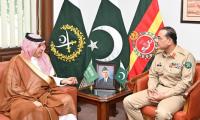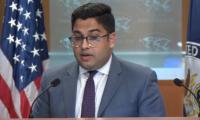The Pakistan Tehreek-e-Insaf (PTI) celebrated its 20th anniversary in style, by staging an enormous public meeting in Islamabad – reflecting the immense popularity that its leader Imran Khan commands. Yet, the party’s tactics and its leadership’s style of politics remain under question.
Khan embarked on his political career in 1996 but remained in the wilderness for the next one and a half decade. In the course of his struggle to carve out a niche for himself in politics, he backed the martial law regime of Pervez Musharraf. Later, he was instrumental in the passage of the 17th Amendment, which put the seal of parliament on the changes introduced by the military regime to the political system.
As a quid-pro-quo for his support, Khan’s 2002 election to the National Assembly was ‘facilitated’. However, his expectation that he would be rewarded big by the regime was dashed. He remained a parliamentarian and nothing more. In desperation, he resigned. But just as he was being written off, Khan surprised everyone by staging a mammoth public meeting in Lahore – the city where political fortunes are made and lost – in October 2011. The rally gave a fresh lease to his hitherto disappointing political life and made him a force to be reckoned with.
Khan’s detractors, however, could smell a rat in his sudden rise of fortune. Be that as it may, Khan posed a serious challenge to the country’s leading political dynasty, the Sharifs, and that too in their own power base – Punjab. In the run-up to the 2013 elections, he seemed close to killing the lion in its den. But it turned out to be a case of too near and yet too far. The Sharifs’ PML-N swept the polls with Khan’s PTI finishing third, behind the PPP. The PTI, however, formed a coalition government in Khyber Pakhtunkhwa (KP).
Khan alleged that the polls were ‘fixed’, a position that he has maintained to date, despite the fact that a judicial commission did not find any evidence of systematic rigging. But that has not deterred him. Except for the army, there is hardly any national institution that he has not pointed fingers at.
Despite announcing and executing various plans to oust the government – a four-month sit-in in the capital’s otherwise most heavily guarded square, starting a civil disobedience movement, staging huge public meetings in big cities and threatening to bring the shutters down in the entire country – Khan’s campaign did not bear fruit. However, the movement did weaken the civilian setup vis-à-vis the establishment.
Until recently, the edifice of Khan’s politics rested on two pillars: the pro-Taliban narrative and the promise of radical change. Khan always questioned the counter-terrorism campaign and advocated that dialogue with the militants was the only solution to militancy. The narrative had three key elements: that the war on terror was not Pakistan’s own but that of the US’; that with a few exceptions (bad Taliban), the militants were essentially men of honour (good Taliban), who had taken up arms in protest against US policies; and that through negotiations, the good militants could be won over. Khan, like his arch-rival Nawaz Sharif, had subscribed to and popularised that narrative in order to win right-wing votes – an endeavour that was partly successful.
The December 2014 massacre of children in the Army Public School (APS), Peshawar forced Khan, and many others, to discard the pro-Taliban narrative. Khan’s position was even more awkward as his party rules the city and is primarily responsible for its security. But to date Khan has not shown any regret, let alone apologised to the nation, for his pro-Taliban stance.
Khan is an enigmatic figure in that he is a rare blend of revolutionary and constitutionalist. The two are poles apart. A revolutionary, with his hawk-like approach, has an inherent dislike of constitutional and legal means of sorting problems, which work at a snail’s pace. A revolutionary is seldom a pacifist as well. Khan opposed a military solution to militancy to the very end. But the same Khan threatened to personally execute any policemen who would dare to mess with his party workers during his dharnas. Perhaps he has the head of a constitutionalist and the heart of a revolutionary.
Khan’s critics maintain that this revolutionary zeal is motivated by a desire to get the seat of power in Islamabad and nothing more; that he owes his own rise to the current ‘unjust’, ‘corrupt’ and ‘rotten’ system; that he joined hands with people who, like him, are among the top beneficiaries of the system; and that throughout his political career he has counted on other elements and forces – the ‘umpire’ – which have stakes in the preservation of the current system.
A mature politician must have the ability to rally political forces around him, so that a united front can be put up against political opponents. But Khan seems incapable of accomplishing this task. His failure is rooted in his self-righteousness more than anything else. He believes that the entire political leadership is corrupt to the bone, while he is a paragon of virtue. Khan seems to know only one way of doing politics, which brings him to the streets again and again. He is, so to speak, the Shahid Afridi of Pakistani politics. Just as Afridi knows only one way of batting, Khan knows only one way of doing politics – lashing out at the opponent.
Khan sees for himself a great opportunity in the Panama Leaks scandal. He appears confident that with his popular appeal, coupled with support from powerful quarters, he can bring the government down. It remains to be seen whether Khan will oust Sharif, or whether his efforts will only make some elements stronger and the political institutions, consequently, weaker.
Email: hussainhzaidi@gmail.com
A woman walks past a building of the International Monetary Fund. — AFP/FileThe annual and spring meetings of the...
Late Benazir Bhutto's daughter Asifa Bhutto Zardari addresses the Christian community in Bihar Colony on January 23,...
Representational image. — PexelsWater is an important scarce natural resource that is required for several everyday...
Pakistani employees of online marketplace company Kaymu at work in Karachi. — AFP/FileThe true spirit of development...
India uses Afghanistan as a backstage area to carry out terrorist attacks against Pakistan
Another report by the Pakistan Institute of Peace Studies states that 78 per cent of attacks have been carried out by...







